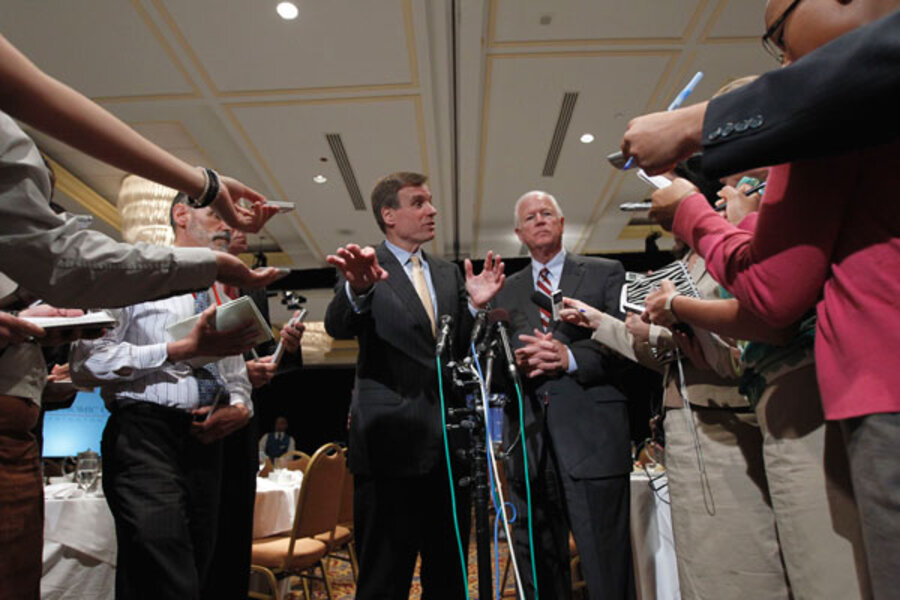'Gang of Six' plan hailed as debt-ceiling breakthrough. What's in it?
Loading...
| Washington
A new spending proposal by the Senate’s bipartisan "Gang of Six" Tuesday is being called a potential breakthrough in efforts to include major deficit reduction in a "grand bargain" to raise the national debt ceiling.
But with Congress running out of time before the Aug. 2 debt-ceiling deadline and partisan forces already criticizing the plan, it faces numerous challenges to break the deadlock on Capitol Hill.
It is, however, seen as having better prospects than the Republicans' "cut, cap, and balance" bill passed by the House Tuesday night in a near-party line vote, 234 to 190. The bill, which would cap future spending at less than 20 percent of gross domestic product and require passage of a balanced-budget amendment to the Constitution, has virtually no chance of passing the Senate, and the president has vowed to veto it.
The proposal by the bipartisan senators in the Gang of Six, by contrast, tries to strike a middle ground between spending cuts and revenue increases and is based on the recommendations of the president's deficit commission.
The details of the proposal have yet to be released. But a five-page draft outlines a plan to cut deficits by $3.7 trillion over 10 years. Key elements include:
- A new bill that cuts $500 billion in discretionary spending over 10 years, including defense spending.
- An immediate freeze of congressional pay and the sale of unused federal property.
- New discretionary spending caps through 2015.
- A requirement that congressional committees report legislation within six months to find billions in savings in entitlement programs over 10 years.
- Creation of a 67-vote threshold to make it more difficult for Congress to exceed its spending caps.
- A longer-term overhaul of the tax code, eliminating many tax breaks and using the savings to reduce marginal income tax rates and pay down the deficit.
- Elimination of the $1.7 trillion Alternative Minimum Tax and the $298 billion Sustainable Growth Rate formula for Medicare (known as the “doc fix”) – provisions aimed at reducing deficits that Congress has routinely bypassed.
- An overhaul of Social Security, but direction of all savings to long-term solvency, not to paying down the debt.
“This is potentially the biggest game changer we’ve had since the debt ceiling discussions began,” says Maya MacGuineas, president of the Committee for a Responsible Federal Budget in Washington.
“Instead of political theater with people trying to figure out how to avoid the tough choices, this is a serious plan that would actually address them,” she adds.
Top Democrats, including President Obama, praised the rare bipartisan breakthrough. Three Republican senators – Tom Coburn of Oklahoma, Saxby Chambliss of Georgia, and Mike Crapo of Idaho – have apparently broken with their party’s pledge to oppose increases in tax revenue. And three Democrats – Richard Durbin of Illinois, Kent Conrad of North Dakota, and Mark Warner of Virginia – have broken with their party’s pledge to oppose entitlement cuts.
Senate majority leader Harry Reid (D) of Nevada called the work of the Gang of Six “extraordinary” and has asked Senator Warner – a member of the gang known for his skills as a “closer” – to report back in 24 hours with elements of the plan that can be used in a deal on raising the debt limit.
But there are many potential pitfalls.
Until the plan is released in detail and scored by the Congressional Budget Office, it’s not clear how much of a dent it makes in the nation’s debt problems – or whether, in fact, it can help lawmakers find a solution to the debt-limit impasse by Aug. 2.
After Tuesday’s announcement of a Gang of Six deal, “there was a little bit of relief rally on Wall Street,” says Stan Collender, a budget analyst and partner at Qorvis Communications in Washington. “But it’s very complicated, and spending cuts are potential.”
And one thing Congress does not have is time. The Aug. 2 deadline, when the US Treasury will lose its capacity to borrow, is real, says Treasury Secretary Timothy Geithner.
Moreover, the first flush of excitement could soon run into partisan realities, says Mr. Collender. “Early press reports that 50 senators had already signed onto the plan turned out not to be accurate,” he says. “I suspect the longer the plan stays out there, the less it will have support. And in the Senate, the relevant number is 60" votes.
Groups at both ends of the political spectrum are already registering their concerns.
“The Gang of Six’s plan is a much grander version of kicking-the-can-down-the-road plans, because it’s mainly focused on procedures to put off decisions about what programs to cut now,” says Chris Edward, director of tax policy studies at the CATO Institute, a libertarian think tank. He adds that the tax hike in the plan is likely to be near $2 trillion over 10 years, but until details are released, it’s not clear.
Meanwhile, liberal groups such as MoveOn.org opposed elements of the plan that would cut benefits in entitlement programs. “MoveOn’s 5 million members are counting on [House minority] leader [Nancy] Pelosi, Senate majority leader Reid, and other Democrats to stand by their promise to reject any benefit cuts to Social Security and Medicare,” said Justin Ruben, executive director, in a statement on Tuesday.





